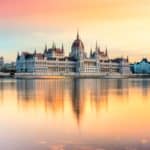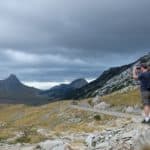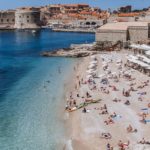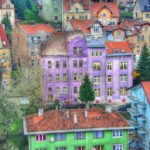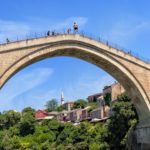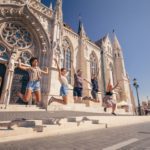Budapest to Ljubljana
Stunning coastlines, historic cities, pristine national parks and some of the most delicious local cuisine your stomach will ever encounter – the Western Balkans have it all. And, this epic 29-day journey will show the best of it. Beginning in Budapest, which is also known as ‘the Pearl of the Danube’, you’ll have the chance to see a range of small towns, bright lights and natural wonders across Hungary, Serbia, Bosnia, Montenegro, Croatia and Slovenia. Your local leaders along the way will be able to give you insights into the different cultures you encounter, with a focus on the people, history and food.
29 days, from
$6,805
per person
GROUP SIZE
ACTIVITY LEVEL
Details
Countries Visited:
Bosnia And Herzegovina
Croatia
Hungary
Montenegro
Serbia
Slovenia
Accommodation: Hotel (19 nights), Hostel (3 nights), Private Apartment (4 nights), Guesthouse (2 nights)
Transportation: Public bus , Private vehicle , Ferry , Taxi
Included Meals:
- 22 breakfasts
- 2 dinners
Group size: Minimum 1, Max 16
Minimum Age: 12
Sip the famous Croatian Traminac Premium wine at a wine tasting at a 15th century family-run vineyard in quaint Ilok
Witness Mostar's famous bridge divers hurl themselves from the stones of a bridge that has spanned the river here for centuries
Sarajevo is one of the most scenically located cities in Europe. See the sights on a guided walking tour and learn about its recent history as a city under siege
Spend a full day exploring the green island of Mljet – with its small seaside villages, lush national park trails, shimmering waters and largely untouched environment, you’ll never want to leave!
Stroll through Plitvice Lakes National Park, marvelling at luminous lakes and waterfalls that seem to have been sketched by an artist
Itinerary
Szia! Welcome to Hungary. Budapest is Hungary's intoxicating capital, on the banks of the Danube River. If you arrive early you could take part in one of our Urban Adventure day tours, such as the Buda Castle Explorer or Bites and Sights. Check them out at urbanadventures.com. After the welcome meeting this evening, perhaps take a night walk along the Danube River to see the surrounding buildings and bridges lit up in lights, or head out with some of your new travel buddies to one of Budapest's funky 'ruin pubs'.
Today you have a full free day to explore Budapest, known as 'The Pearl of the Danube'. Admire intricate carvings on resplendent buildings, cross the iconic Chain Bridge to explore the Castle District, or simply meander through winding streets snacking on local delicacies. Budapest is a great city to enjoy from the water. Perhaps take a boat trip along the river or catch a funicular up to the castle for spectacular views of the Parliament Building. With so much to see and do, hiring a bicycle is another great way to move between the sights. Perhaps head to Statue Park to see the communist monuments that were removed from the city after the fall of the Iron Curtain. You might like to take a tour of the beautiful Hungarian State Opera House, or check out the Hungarian National Museum. One unmissable activity is a soak in the healing waters of Budapest's hot thermal baths.
Travel by private van through the Hungarian Puszta and cross the border into Croatia to a land of cornfields, vineyards and pastel-hued villages, famed for its cuisine – arriving at the Slavonian capital of Osijek (approximately 4 hours). This laid-back university town features an enchanting medieval citadel (tvrđa), as well as the Upper Town, only a short walk along the banks of the Drava. Many cafes line the river, inviting you to join in on the Croatian national pastime: people watching. Osijek is a fairly well-designed city easily navigated on foot. There are also numerous cycling routes throughout the city. Navigate the hallways of grand buildings, stroll along the banks of the Drava River or pick up the true flavours of this destination at a local cafe. Our accommodation is at our long-time friend's guesthouse, located right inside the citadel. The guesthouse is family owned, and local wine and craft beer are always on offer.
Today is a free day to explore Osijek and its surrounds. You might like to visit the small provincial town of Dakovo, about 35 kilometres south of Osijek. The town is dominated by an impressive neo-Romanesque cathedral. While here, don't miss seeing a workout session at the Lipizzaner horse training stables and learn about their history from a local guide. You could also use the day to do a full day trip that includes a visit to the wetlands of Kopacki Rit Nature Reserve for a spot of bird watching, nearby Tikves Castle, historical Batina Hill from where you can see both Hungary and Serbia across the Danube, wine tasting at Belje wine cellar and lunch at the etno-village at Karanac. In Osijek itself there’s the Museum of Slavonia and the Archaeological Museum to explore. Or you could just hire a bike and cycle around this delightful region. However you're feeling, there are plenty of options to choose from today. This evening, maybe discover some of the best cuisine in Croatia with traditional dishes like fiš paprikas (fish stew with hand-made noodles), kulen (spicy sausages), and čobanac (stew).
Today travel to Novi Sad by private minibus. Learn more about recent history by taking a side trip to nearby Vukovar en-route, a town that symbolises the devastation of the recent war – the town fell in 1991 after the fiercest and most protracted battle seen in Europe since 1945. The town's ruined water tower now stands as a memorial of the ethnic war that raged in this region during the early 1990s. Our stop includes a visit of the local hospital and the museum in its basement. It was used as a refuge during the siege, and the group will be shown around and hear wartime stories from hospital staff, some of whom still work here and who were among the few survivors. Next up is a visit to a local vineyard in quaint Ilok to see the workings of a family-run vineyard. The old wine cellar dates back to 1450, and is the first originally purpose built wine cellar in this part of Europe. Taste a range of their wines, including the famous Ilok Traminac Premium wine, which was served at the celebration of the coronation of Queen Elizabeth II. Head across the border into Serbia to the historic town of Novi Sad (approximately 1 hour). Sitting on the banks of the Danube River, the city is surrounded by fertile farms and vineyards and features an interesting mix of traditional Serbian cultural heritage and Austro-Hungarian architecture. During your free afternoon make sure you stop by the city’s fortress of Petrovaradin, which sits right on the Danube and contains a museum of historic artefacts from the region.
Travel by two-hour train or bus to Belgrade. Known as the' White City', Belgrade is one of the oldest cities in Europe. Sitting at the confluence of two major rivers the – Sava and the Danube – it’s an important intersection between Eastern and Western Europe. Here you’ll experience an energetic mix of progressive flamboyance and conservative customs. On arrival, enjoy a guided tour of the city’s wide boulevards and squares, and the historic and green heart of Kalemegdan Park. The park is home to Kalemegdan Fortress, which has overlooked the Danube River here for centuries. In the evening, head down to Skadarska Street in the bohemian quarter of Skadarlija to sample some authentic local food and enjoy the lively atmosphere, in a place where Orthodox churches vie for space next to fashionable nightclubs.
Today is a free day to further discover Belgrade. You might like to take a cruise along the Danube River, passing the Kalemegdan Fortress, Pancevo Bridge and Zemun. Make sure you visit the imposing Hram Svetog Save (St Sava Church). Alternatively the local market Zeleni Venac can keep you occupied for hours. Perhaps take a stroll through the Nikola Tesla Museum to learn about the life and work of Serbia's greatest inventor, or check out the city's Ethnographic or Military Museums. You can climb the 36-metre, 1896 Gardos tower in Zemun for sweeping views of the city and the Danube, or get a crash course in Serbian contemporary art at Zepter Museum. If the weather is warm, why not brave the crowds on Ada Ciganlija beach, where you can swim, take part in water-sports or simply soak up the sun with a cocktail. Throughout the summer months, Belgrade hosts a variety of musical and cultural events and the city is abuzz with people and activities. The city’s nightlife has become legendary throughout Europe, with several hundred floating bars, restaurants and nightclubs lining the Danube and Sava rivers.
Today travel by bus through beautiful countryside to Sarajevo. The journey will take around eight hours in total, so sit back and enjoy the scenery. Sarajevo is Bosnia and Herzegovina's small but vibrant capital. Twenty years after the end of a devastating war, Sarajevo is slowly asserting itself as one of Europe's most beautiful and interesting destinations. The city often draws comparisons with Istanbul as a city that mixes east and west – dotted with minarets, mosques, bazaars and the aroma of coffee. On arrival, embark on a guided tour to gain an insight into the history and culture of the city. Sarajevo is one of the few cities in the world that features an Orthodox church, a Catholic church and a mosque (the famous Begova Džamija) all within close proximity. In the evening, perhaps enjoy a simple but delicious meal in Bascarsija, Sarajevo's old bazaar. Out from here the city’s history unfolds – from Ottoman-era buildings to the elaborate constructions of the Austro-Hungarian period and on to the ugly structures of the communists. Try the local speciality of bosanski cevapi (grilled minced meat mixed with mild spices).
Today head out of Sarajevo for a day trip to Mostar, a town situated in a beautiful valley in the high mountains of Herzegovina (approximately 2.5 hours). Thanks to the river Neretva Mostar was able to develop as a city in the barren landscape of Herzegovina. Neretva's size turned Mostar into a trading centre of the region very early on. The city was the most heavily bombed settlement in Bosnia during the war, but it has since been rebuilt and now features on UNESCO's World Heritage list. On arrival, head to the famous Stari Most Bridge, first built by the Ottomans in 1565 – it was the great architect Mimar Hajrudin who succeeded with the impossible mission to cross the Neretva River with a single span stone bridge. The bridge also made headline news during the Yugoslav wars when it was destroyed in 1993. It was rebuilt and reopened in 2004, and there’s an interesting museum about its history next to the bridge itself. If you’re lucky you’ll see the famous bridge divers hurl themselves into the icy waters below. It’s a tradition for the young men of the town to make the jump, and it’s now an annual competition. Return to Sarajevo in the afternoon, not without a stop at Konjic where you’ll discover one of the best-kept secrets in former Yugoslavia, Tito's nuclear bunker. Go back in time on a guided tour of the bunker and learn about Yugoslav history and how life used to be in not-so-distant past. Tonight you may like to join your group for dinner at a local restaurant.
Enjoy a free day in and around Sarajevo. You could take an optional day trip out to the thermal springs and green parks of Ilidza, the source of the River Bosna. You might prefer to discover local history with a visit to the History Museum and the Sarajevo War Tunnels (dug underneath the airport runway and used to smuggle provisions into the city during its siege), or learn about the tragedies faced by the city's Jews at the Jewish Museum. Perhaps get cultural with a stroll through the Art Gallery of Bosnia and Herzegovina. Perhaps return to Baščaršija and get lost in the mosques, caravanserais, and stone-vaulted bazaars, snacking on burek or ćevapi, or ramble along through Park Prinčeva for views of the city. The Pivnica HS brewery, which also has a restaurant, is a good place to sample local award-winning beer and spend an evening.
Board our private transfer and travel through beautiful countryside to Montenegro, arguably one of the most stunning countries in the world. The drive today is long (approx 7-9 hours) but very scenic, and we will stop numerous times, so have your camera at the ready. Get back to nature by travelling into the heart of the beautiful Durmitor National Park. This World Heritage site was formed by glaciers and is crisscrossed with rugged mountains (40 of which reach over 2,000 metres in height), pristine pine forests, two deep canyons, rivers, crystal lakes and underground streams. Enjoy a hike through this wonderful, lesser-explored wilderness, along the shores of a lake (approx 2km). Keep an eye out for some of the 163 species of bird or 50 species of mammal that the region is home to. If you prefer to opt out of the hike you can instead just take in the tranquil surrounds until the group returns. Continue to the nearby town of Niksic where you will spend the night.
Today drive to Kotor (approximately 3 hours). This 5th-century World Heritage-listed city is set on a secluded bay, with towering peaks surrounding a rocky coastline dotted with pretty waterside towns. Upon arrival why not head out to see the 12th-century Cathedral of St Tryphun, the South Gates of Kotor (the Gurdich Gate) and the Armoury Square (Trg od oruzija). You might like to get delightfully lost in the crooked alleyways, checking out the boutiques and cafes, or climb the hills behind the city to visit Kotor's ruined fortification walls. A one-and-a-half hour hike up the stone steps, past churches, gates, and bastions to the Fortress of Sveti Ivan at the top rewards you with magnificent views across town and the brooding Bay of Kotor. In the evening the city walls are prettily lit up to provide a unique night-time perspective.
Today you have the opportunity to take part in optional day trips out of Kotor. Perhaps take a cruise on Kotor Fjord, visiting the twin islands of Our Lady of the Rocks and Sveti Dordje (St George), with its church in the middle of the bay. Legends has it that sailors once spotted an image of the Virgin Mary on a rock here, and so then each time they completed a successful voyage they added another rock as an offering. Eventually so many were added that an island emerged and the church was built on top of it. Alternatively, consider a trip to Budva, a mere 30-minute busy ride out of Kotor. With its busy beaches, charming Old Town, bustling restaurants and bars, Budva is like Montenegro's little version of Miami. For some more history, head up to Montenegro's former capital Cetinje, now a laidback village with grand mansions that were used as embassies in days gone by. Enjoy a final night in Kotor, perhaps by listening to some of the live music that gets the cobbled streets busy.
Depart Montenegro on a three-hour bus journey along the beautiful southern coast of Croatia to Dubrovnik. Dubrovnik's walled old town is often referred to as the pearl of the Adriatic despite its tiny size, and it's now famed for it's part in the TV show ‘Game of Thrones’. On arrival, head out on a walk along the city walls with your leader, enjoying views of the sparkling Adriatic Ocean. You'll also visit Big Onofrio's Fountain, built by the European architect Onofrio della Cava in the 15th century to supply water to the city. Afterwards, perhaps check out the 13th-century Franciscan monastery or the Sponza and Rector's Palaces, the only Renaissance buildings in the city to survive a devastating earthquake and fire in 1667. You might like to visit the city's War Photography Museum, or if you have time, even take a boat trip to nearby Lokrum Island, where you will find the French-built Fort Royal Castle, a monastery, and a botanical garden that dates back to when the Austrian archduke Maximilian had his holiday home on the island. At the end of your journey, perhaps you'd prefer to simply unwind on a beach. On the last night of your trip, why not enjoy one last meal with the group and toast to your adventures.
Today is a free day for more discoveries in Dubrovnik. You might like to visit the city's War Photography Museum, or even take a boat trip to nearby Lokrum Island, where you will find the French-built Fort Royal Castle, a monastery, and a botanical garden that dates back to when the Austrian archduke Maximilian had his holiday home on the island.
Start the day by beating the crowds with an early morning walk along Dubrovnik's famous 2-kilometre-long city walls surrounding the old town. Enjoy views of the sea from the fully intact medieval structure, then enjoy all that Dubrovnik has to offer with the remainder of the day free for you to explore. Visit Big Onofrio's Fountain, a masterpiece built by famous European architect Onofrio della Cava. This 15th-century landmark was built to supply water to the city, flowing from the spigots into the collection trough surrounding it. Be sure to check out the Franciscan monastery with one of the world's oldest, continuously functioning pharmacies, founded in the 13th century. If you still feel energetic after a day exploring the city you can take the switchbacks leading up Srd Hill behind Dubrovnik for spectacular views of the city and the Dalmatian coastline. Otherwise, the newly restored cable car can whisk you to the top in no time. The hill is topped by a castle of Napoleonic times, which now houses the Museum of the Croatian War of Independence.
Journey to Korcula (approximately 4 hours). You will travel along the narrow and scenic Peljesac Peninsula to its very tip. The last stretch to Korcula will be done by car ferry. For the next two nights, stay with generous hosts – locals who rent out their rooms in the summer season. The rooms, while simple, are the best way to put money back into the local economy. In the evening perhaps head out to a local restaurant. Make sure you try the traditional Dalmatian meat loaf, or pasticada (traditional stewed beef), and some fresh grilled vegetables with olive oil, usually served with fresh goat and sheep cheeses, and maybe some smoked ham to tie it all together. Don't forget to have a bit of travarica (a grappa-like drink made with a herb called verbane) and some Korcula cakes for dessert.
Today, head on a day trip to the stunning Mljet Island. Mljet is Croatia’s greenest island, with a large section of the north western shores part of a national park. The island is well known for its two salt lakes – Veliko Jezero and Malo Jezero (big lake and small lake) – that are located at the north end of the island. With some of the clearest waters in the world, any of the Adriatic islands shimmer in the sunlight, but Mljet is extra special. Start Mljet's exploration with a short hike into the island's interior, followed by a ferry ride to St Mary's Benedictine Monastery, located on an island in one of the lakes. Spend the day discovering its tiny towns dotted around the island, the weaving and winding coastline full of nature walks and scenic lookouts and, of course, the sandy beaches, tranquil inlets and turquoise blue shores calling out to be explored. Mljet is a little further away and less visited than the tourist hotspots of Brac and Hvar, so you’ll be able to stray away from the crowds and have this peaceful paradise to yourself. Head back to Korcula in the afternoon for a relaxing evening, hopefully full of delicious food and some great local wine.
A hydrofoil ferry takes you to the neighbouring island of Hvar (approximately 90 minutes). Beautiful Hvar has an air of Venice about it and is known as the 'Queen of the Dalmatian Islands'. Upon arrival, get to know the town with its wonderfully preserved Renaissance facades on an orientation walk. Later you may want to visit the 16th century Spanjola Fortress, from where spectacular views over town and this part of the Adriatic can be had. Feel the history when wandering the backstreets of quirky galleries and unique boutiques, watch the fishermen bring the day’s catch into the harbour, and chill out over a few cocktails in a waterside bar.
Today is a free day to explore this island at your leisure. Perhaps take a bus to the interior of Hvar Island where you can take a leisurely hike through the abandoned villages of Velo Grablje and Malo Grablje, gently descending all the way down to the sea at Milna Bay. On the way you can witness what remains of the typical Mediterranean life that flourished on the Croatian islands in the 18th and 19th centuries. Hike past dramatic jagged limestone cliffs and slow your pace to enjoy the undulating farms, fields of lavender and rosemary, and ancient olive groves. Cool down in the shimmering waters upon arrival into the little town of Milna where the hike ends. Alternatively there are plenty of other options for exciting activities in town. Maybe take a short boat ride to the nearby Pakleni islands – largely uninhabited and often described as being among the most beautiful in the world. If you’re not feeling super energetic today, spend the day lounging at one of the island's many quiet beaches and enjoy a sunset stroll along the harbour promenade. In the evening head to Hora – a local farm-style restaurant, where you’ll have an included dinner in the surrounds of UNESCO-protected fields and farmland, where little has changed since the Ancient Greeks arrived almost 2400 years ago. Taste award winning wines, olive oils and other Dalmatian delicacies like local cheese and prosciutto accompanied with a traditional peka style meal or grill and finish with a Dalmatian desert.
Catch a boat to Split (approximately 1 hour). Situated on a small peninsula on the eastern shores of the Adriatic Sea, Split is the second largest city in Croatia. Join a local guide for a walking tour of this stunning seaside town and get to know its history. See the original and fantastically preserved basements under the city, as well as the Cathedral in Diocletian's Peristyle and Jupiter's Temple. Explore the impressive ruins of Diocletian's Palace – Split's most imposing structure and some of the most interesting ruins on the Adriatic coast. Portions of the Palace are over 1700 years old and there’s ample time to walk around. Split grew out from Diocletian's Palace and you can almost see it evolving in a multitude of different ways right before your eyes. Some cultures might have made the palace a museum, but Split is a dynamic and vibrant place, and now the palace houses many businesses and homes. If your feet get tired, why not grab a drink at a cafe on the Riva Promenade and people watch for a while? Be sure get your group together for a harbourside dinner – it’s time for more of a relax!
Take a full day to explore Split further. You might like to take a day trip to the surrounding area and visit the ancient Roman city of Salona, or the sleepy towns of Trogir or Sibenik. There will be a meeting at 6 pm to welcome any new travellers joining you on the next stage of your adventure. In the evening why not head out for some fresh seafood with your travel companions?
This morning, you'll travel by local bus northwest to Zadar. For centuries Zadar was the capital city of Dalmatia, and the city's rich heritage is visible at every step. An important coastal town, the musical steps of the ‘Sea Organ’ on Zadar's waterfront express its important relationship with the sea. Trace marble streets through the Old Town and discover Roman ruins in amongst medieval churches. Enjoy some local food and drinks in a city that’s home to a vibrant café culture. Zadarsko pivo is a light beer with a very pleasant taste, just a little bit bitter, with a rich flavour. Afterwards, perhaps treat yourself to a gourmet meal at a contemporary Croatian restaurant. Try lamb in red wine, 'njoki' with Dalmatian ham and rocket salad, or opt for the popular choice of fresh fish: tuna carpaccio or a fillet in scampi sauce. Also try the famous liqueur, Maraskino, made from locally-grown maraschino cherries according to a centuries' old secret recipe. This unique drink was a favourite at European imperial and royal courts and has been produced in Zadar since 1821.
Head out of the city this morning and enjoy a special experience meeting with the local Benedictine nuns on a visit to their nunnery and their farm. You'll get a chance to connect with them and learn about their way of life in the nunnery and on the farm. You'll even get the opportunity to taste test the preserves and pickles they make on the farm. After some time to explore and meet the locals, you'll head back to Zadar in the afternoon and enjoy free time in this charming and vibrant city.
Take a drive inland and travel north to your next base of Grabovac. Here, you’ll visit Plitvice Lakes National Park, a misty Eden of endless waterfalls and spectral blue lakes. Fed by the Bijela and Crna (White and Black) Rivers, the waters tumble from a high, tree-lined ridge down through the valley and skirt dense forests of beech, spruce and pine. A series of wooden walkways pass over the landscape, ensuring there’s little impact upon the park. Sixteen stunning turquoise lakes, fed by underground springs, are split into the upper and lower lakes. The upper are in the dolomite cliffs, where rushing water weaves in and out of the karst, dropping dramatically down to the lower lakes, with enchanting forests, grottoes and steep cliffs. This interplay of water, rock, and plant-life creates a wondrous, dynamic landscape, changing the water colour from azure to bright green, deep blue to grey. Look to the canopy for over 120 species of birds, including hawks and owls. The butterflies that hover through the trees transform the park into a riot of colour in the autumn. Even amongst this pristine natural beauty, the Plitvice Lakes are shadowed by the region's history. The 1991 civil war erupted here after rebel Serbs took control of the park's headquarters, holding the park for the duration of the war and devastating infrastructure, though thankfully leaving the natural landscape intact.
Continue to Croatia’s capital and largest city, Zagreb. Full of parks and squares, Zagreb is a laid-back place, proud of its coffee culture and the perfect spot to simply wander. Follow your leader on an orientation walk upon arrival and then enjoy some free time for the rest of your day here. Maybe join in one of the many free walking tours in the city and engage with a local here to learn about their daily life, or browse the city’s stunning architecture from neo-baroque to gothic and more. You could check out Tkalciceva Street’s lively social scene, or head up Medvednica Mountain where the views stretch as far as neighboring Slovenia on a clear day. To live like a local, may be head to Zagreb’s open-air markets where you’ll find all kinds of fresh vegetables, nuts, honey and liqueurs. With plenty of things to do and sights to see in this city, your choices for today are endless.
This morning, take the train and cross the border to Ljubljana first. One of the smallest capital in Europe, Ljubljana makes up by being one of the greenest and vibrant city in Europe.Follow your leader on an orientation walk here and then take the funicular up to Ljubljana Castle where you'll have a great view of the city. After some time here, take a local public bus and continue to Bled, situated on the stunning lake of the same name. Take in the mountainous backdrop, lake, and impressive cliff-top fortress, which all combine to make this a wonderful place to visit. There are many outdoor activities to get the blood pumping in Bled: rafting, caving, canoeing and swimming, to name a few.
This morning embark on a walk around beautiful Lake Bled with your leader. This scenic walk passes some impressive villas, mostly from the beginning of the 19th century, including the residence of the former Yugoslav president 'Marshal' Tito – today the Hotel Vila Bled. The rest of the day is free for you to explore all that Bled and the surrounding area has to offer. If you’re feeling active, consider riding out to Vintgar Gorge (4 kilometres) and walk through the natural canyon. Bled is renowned for its mild, healing climate and thermal lake water. Maybe head to the 100 metre high cliff-top Old Bled Castle, dating from the 11th century and overlooking sparkling Lake Bled, then take a Pletna boat ride (a wooden, awning-covered boat rowed by a special oarsman) to the island on Lake Bled – climb up the 99 steps to St Mary's Church and ring the wishing bell. Be sure to seek out the famous Bled cream cake, which isn’t hard; nearly every cafe and cake shop in town claims that theirs is the best. You might even consider doing a day trip to nearby Ljubljana, Slovenia's compact yet cosmopolitan capital city. Then, why not celebrate the end of a remarkable journey with a final group meal.
There are no activities planned for the final day and you are able to depart the accommodation at any time. As there is so much to see and do in Bled and the surrounding mountains you may want to consider extending your trip and stay longer in Bled. We are able to book additional accommodation for you, subject to availability. Please enquire at the time of booking.
